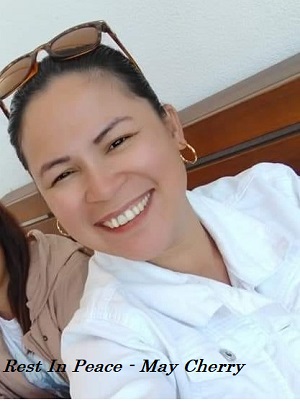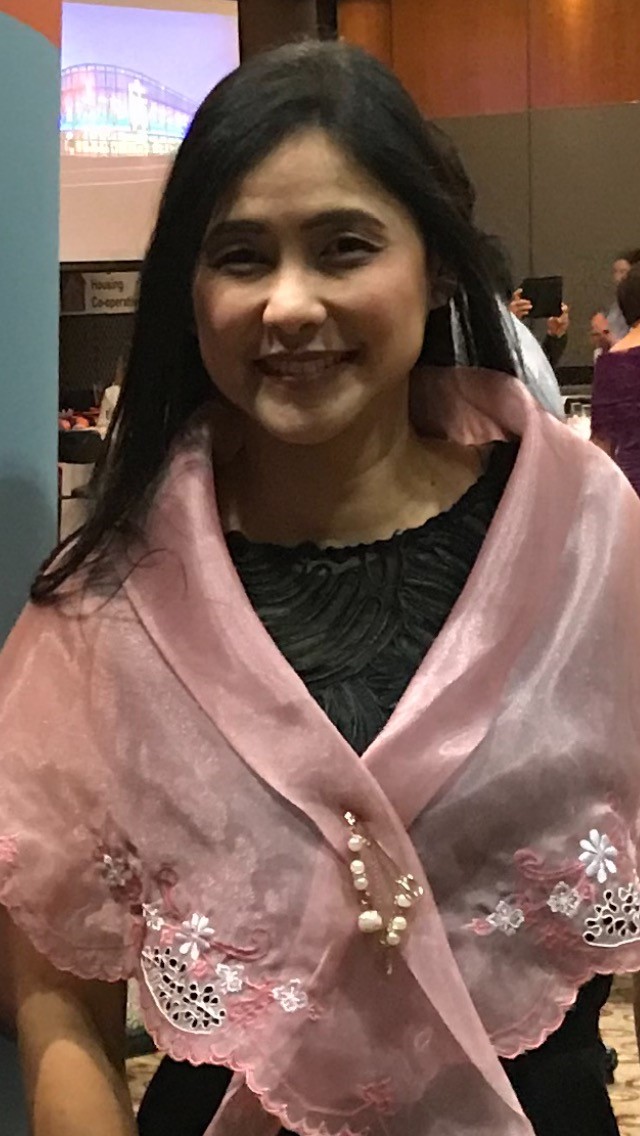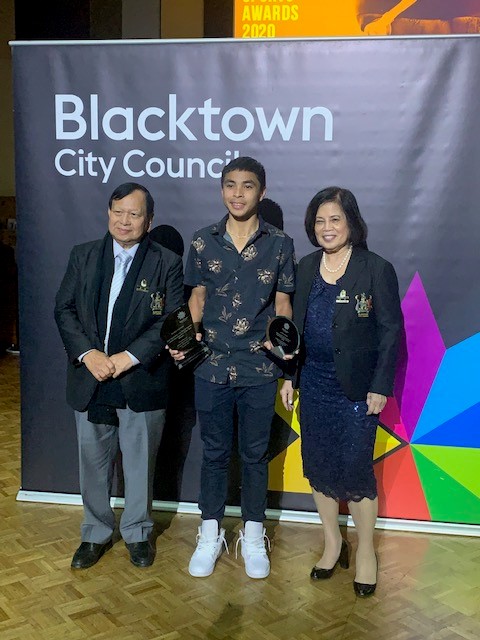
(Photo on FB)
The Filipino-Australian community has been rocked with disbelief, anger and sadness by a recent piece of news that a Pinay perished due to suspected domestic violence (DV). Thirty-seven year old May Cherry Gerente-Ogar of Yorke Peninsula, South Australia suffered severe head injuries among other signs of being bashed with great force.
Seven News reported that:
“Police were alerted to the incident about 12.30pm on Monday, 26 July after a woman was transported by paramedics to the Wallaroo Hospital before being transferred to the Royal Adelaide Hospital with life threatening head injuries,” SA police said in a statement on Wednesday.
“The 37-year-old victim died in hospital today.”
A court on Tuesday heard Cherry Gerente-Ogar was allegedly bashed within an inch of her life by her husband, Antony Ogar, on Sunday night. The 58 year old man has been held in custody and disallowed bail, with the charges of assault likely to be upgraded to murder.
Domestic violence has been one of the serious social issues that have caused problems to the Australian society and indeed in most of the countries globally. Right now, a media awareness campaign is being undertaken to highlight that society needs to do more preventative work, and to start teaching young people about bullying and violence towards girls.
WHAT IS DOMESTIC VIOLENCE?
Domestic violence or abuse covers a range of types of abuse, including, but not limited to, psychological, physical, sexual, financial or emotional abuse. ‘Domestic abuse’ can be prosecuted under a range of offences and the term is used to describe a range of controlling and coercive behaviours, used by one person to maintain control over another with whom they have, or have had, an intimate or family relationship.
Domestic abuse is rarely a one-off incident and is the cumulative and interlinked types of abuse that have a particularly damaging effect on the victim.
Acts of domestic violence fall within the scope of Crimes Act NSW. Corresponding penalties including imprisonment are underpinned by legislation.
If the offence is not serious, the Police will issue an Apprehended Violence Order (AVO). . This is dealt with in the Local Courts depending on level of severity of injury sustained by the victim or the seriousness of the complaints. The police is informed by the victim or by an interested party, another family member, a neighbour or a friend. If injury is accidental, and there is no intention to harm the victim, the court may order suspended sentence of about 12 months.
AVO claims can also be defended. If the injury is severe, more likely the courts can hand a jail sentence with or without bail.
The Australian Filipina spoke to two Fil-Aus female professionals who deal with DV cases. These are Reia Salazar, an experienced social worker and Linda Geronimo Santos, a lawyer also with many years of exposure to DV cases.
SHARING FROM A SOCIAL WORKER'S PERSPECTIVE

Reia Salazar has been a social worker for 14 years now and she has been dealing with, and continuously learning about, DV for this length of time. She has dealt directly with DV cases particularly in the first 8 years of working in her field.
Reia's sharing on DV is as follows:
With technology these days, it is very easy to Google the definition of domestic violence so I’ll leave the “Googleing” to our readers and I will try to explain DV in a simple way. The way I would define DV is when there is a repeated cycle of violence and abuse in a relationship between [intimate] partners where there is an imbalance of power and there’s an element of control by the person with “more power”. This definition has 3 components which I’d like to briefly explore. First is “violence and abuse”-- When we hear the word violence we often think of physical violence but in DV, violence and abuse comes in many forms such as verbal abuse, financial abuse, physical assault, emotional abuse, psychological abuse, sexual violence, social abuse, to name a few. It is important to note that this is not a one-off event but a vicious cycle that happens repeatedly. Second is DV is between partners who are intimate or what we call romantically involved; although of course there is nothing romantic about being in a DV situation. Third is there is a perceived imbalance of power whereby one person is able to control the other through the different forms of violence/abuse mentioned.
Does DV happens in the Fil-Au community? The simple answer to this is a resounding yes. The reason why I say this is because there are many Filipinos coming to Australia through the sponsorship of a partner/ boyfriend/ girlfriend/ fiancé. That in itself already presents with an imbalance of power because they are new to a country, do not know anyone, may not have money or there may be a language barrier--- in short they may possibly be dependent on their sponsor for many things. Another imbalance would be that the sponsor is perceived to be more superior because the Filipino is coming from the Philippines, most of them trying to escape a poor country, and is “lucky” to be brought to a developed country like Australia.

In all of the DV cases I have encountered, the perpetrator (meaning, the one causing the DV) appears to be “quite charming and says all the right things”. Isn’t it when we think of monsters, they’re always scary and ugly but with DV that may not be the case and so it’s easier for them to fool their victims into a false sense of security. With DV perpetrators, in public they have a good image but behind closed doors that’s when they perpetrate the abuse. A few of DV victims I have dealt with involve Filipinas who came to Australia as a girlfriend/fiancé. Another DV case that stands out to me is one wherein it is the female who is the abuser so it is not true that DV is only done by men on women. I have also come across a case wherein we have helped a mother escape DV, was in a secret secure location but sadly eventually she went back to the perpetrator. It is truly mind-boggling and many would probably say “What??!”. It is important to note that in most cases, it takes several attempts before a victim is successfully free of the perpetrator. Well think about it, giving up smoking or alcohol takes several attempts, what more being free of DV.
In the Child Protection realm, domestic violence is grounds for the government to remove children from their parents. If the victim (i.e. mother) is willing to leave the perpetrator, then the government will support the mother and the children and keep them safe. If she is not willing to leave the perpetrator, then it is possible that the children will be removed from the parents and taken into the foster care system due to risk of psychological harm on the children.
There are those who ask: why did she not report to the police or ask for help? It is important to note that DV is a process so the victims are in a situation for a period of time wherein they have been brainwashed/ coerced/ threatened/ manipulated into thinking and feeling certain things (for example being told no one will love you, if you leave me I will kill your children/loved ones, I will hunt you down wherever you go) until the victim believes it and becomes resigned to being in a helpless state. Imagine this three step vicious cycle:
the perpetrator hurts the victim-à then he apologises, professes love and promises to never do it again à the victim forgives him (because she believes him and genuinely wants the relationship to work, or to keep the peace) and it will be good for some time because keep in mind the perpetrator can be charming when he wants to be à and back to step 1 where perpetrator hurts the victim. When someone is caught up in this vicious cycle, it’s hard to get out of the rut.
Also, for instance in a situation where you fear for your life or that of your loved ones, and believing that this person is capable of all those things he has threatened, a victim is manipulated into being rendered mentally, physically, emotionally and psychologically drained into submission and being in a helpless state because the perpetrator has control over her so it is not easy to say just report to the police and ask for help.
My advice to anyoe who maybe in a DV situation is that there is HOPE and there is support available to you. You have a lot of strength in you. Even when you have tried and failed in the past, please persevere. You can do it.
SHARING FROM A LAWYER'S PERSPECTIVE

Linda Geronimo Santos is a solicitor with 30 years of experience and an elected Councillor of Blacktown City Council. She worked as lecturer at a university in Manila, part-time lecturer of law in a university in NSW, and part-time lecturer of Diploma courses in Management and Administration.
Below are her personal encounters with domestic violence cases.
On many occasions I receive midnight calls from clients picked up by the police for domestic and other violence issues. I do not know the clients; usually the parents speak to me as the accused does not know his rights. I speak to the client, then I explain the rule of law - and his rights even as an accused person; I then speak to the arresting officer. Nine out of 10 cases, the accused is allowed to go home free. If the case is serious warranting police and Court intervention, I make representations in court on client's instructions.
I have encountered more domestic violence issues in migration cases. In the matter of X my client was sponsored by an Australian husband; they had a minor/infant child. There were domestic problems - the husband wanted to get rid of the mother and their child. The mother and the child were staying in a refuge shelter because the husband refused to share food, money for maintenance of the family. He was also financially and emotionally abusive to the wife and to the child., and he withdrew his immigration sponsorship of this family unit. My client refused to take it up with the Police. The wife did not want to involve the police . I took the case to the Immigration Department, and we won the immigration case based on domestic violence.
In the matter of Y the husband continuously sent offensive email and phone messages to the wife. The husband also refused to provide financial maintenance for the wife. He also invited his female friend to share the household. We had sufficient evidence to prove domestic violence and we took the matter to the police hand the husband was charged and convicted accordingly.
In the matter of Z violence took the form of a videotape showing the husband/father husband hitting the child with a belt. The husband was taken to court; the video tape was sufficient evidence of domestic violence, and the matter was dealt with accordingly.
Where the victim is my client, we go to court and file an Apprehended Violence Order (AVO) application. If the injury is severe, the police and the police prosecution take over, the perpetrator goes to jail, until such time when the matter is heard in court and the perpetrator is sentenced by the court accordingly. In the interim, if there is potential risk of flight by the accused or further risk of violence to the victim, bail application is likely to be rejected by the court.

(L-R: Councillor Jess Diaz, youth awardee, Councillor Linda Santos)
I am more a criminal defense lawyer. I represent victims of domestic violence frequently in the family courts because here is usually a nexus between family law issues and domestic violence, specifically where the matter involves child custody. On one occasion, the presence of the husband was so menacing that I asked the court to provide security for my client. Security officers were assigned at the court venue.
There were cases where the partner (usually the male partner) killed the victim within the court precincts. This is one reason there is tight security in the courts today.
On one occasion I was working with the court on before Christmas trying to retrieve the child whose father took her to another part of the State. We got the court order, and got the child back in time for Christmas with her mother and the family.
I have encountered cases where children are victims of domestic violence where the parents get government subsidy, neglect the children, and the money is spent on drugs, alcohol and gambling. I usually resort to get assistance from the government child support system and the child/children are placed in foster parents’ care. This is more common in remote areas.
There is also violence in school. I assisted a parent by phone whose child was accused of stealing a credit card from the school cafeteria. The child was accused in front of her classmates and other teachers. I asked the mother if the credit card was found in the possession of the child. She said, no. But because she was at the cafeteria, the teacher accused the child of theft. The mother was advised that the matter will be taken up with the local police the following day. The mother was frantic, and was crying not knowing what to do, and had no money for a lawyer.
I advised the mother that I would represent the child via zoom or by phone as they live interstate . The next morning the mother rang me to thank me. When she mentioned that the child had legal representation, the school principal dropped the case/allegation and advised the mother accordingly.
More often domestic violence is triggered by mental health issues like problems with anger management. When I face this challenge, I advise the client to seek help to address anger management. The dilemma facing a practitioner like me is whether to take it up with the police as I have no sufficient evidence to warrant police intervention.
Domestic violence cases are increasing in number. Sometimes the victim assists in letting the perpetrator evade/avoid the law. A mother was killed by her daughter; she advised the authorities when steps were taken to take the perpetrator to a mental health facility, that the daughter was not out of control and should be alright. She was killed by this daughter in the most horrendous manner.
We are lucky in this country that we have facilities for victims of domestic violence, e.g. shelters, government subsidy, health facilities, etc. Nonetheless these do not deter perpetrators of domestic and family violence. Unfortunately the law operates only when the victims speak out.
Just recently, with the help of like-minded community leaders, I helped organise a non-profit organisation called Australian Filipino Women’s Support Group Inc, aiming to promote advocacy and empowerment of women and children who are victims of domestic violence.
WHAT TO DO WHEN CONFRONTED BY DV SITUATIONS?
We have many cases of years that women endure DV, until they had enough and either kill the partner or they get killed. This because in domestic relationships, the victim tends to hope that the perpetrator will change and the relationship will improve; or they bear with it for the children's sake.
One of these government agencies is the Department of Communities and Justice (DCJ). This formerly operated and was known as the Department of Community Services - DOCS). DCJ has provided information about their services in various languages including Pilipino.
The link to this page is:
https://www.facs.nsw.gov.au/language-support/tagalog?fbclid=IwAR1LjCKfa3sdbHJko9Ah4fE_xoyn3jhAPW_4NLAVgCOor6E9jYItW3KaAoU
Hard as it may be, the first important step for anyone in a DV situation is to talk to someone. This is the way to be guided to approach the right entity which can do something for you or guide you to the right entities.
The Australian Filipina extends condolences to the family of the late May Cherry Gerente-Ogar.